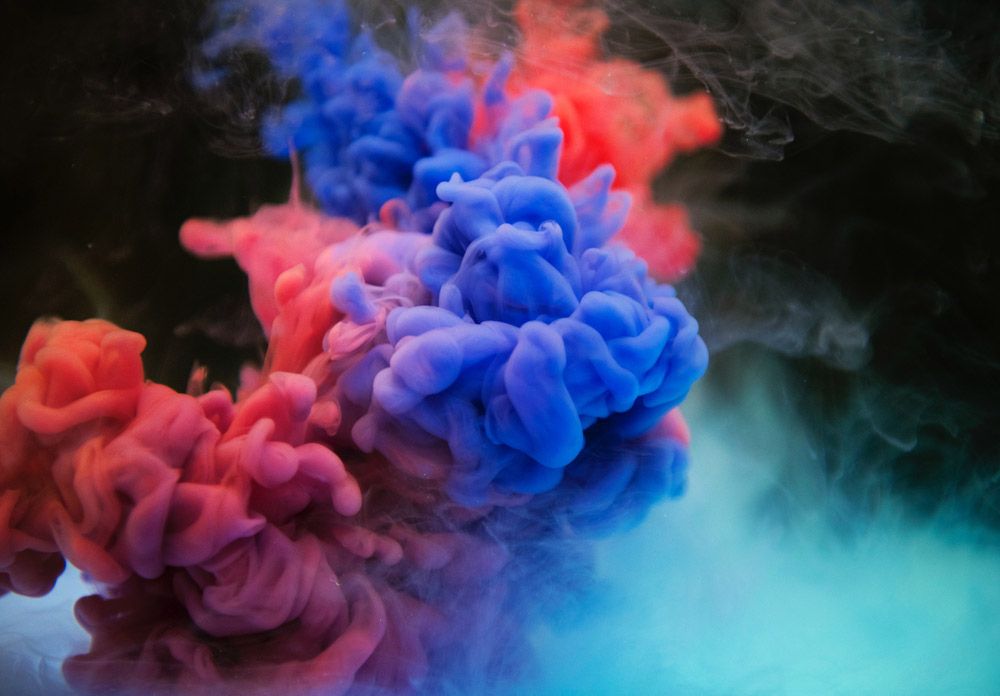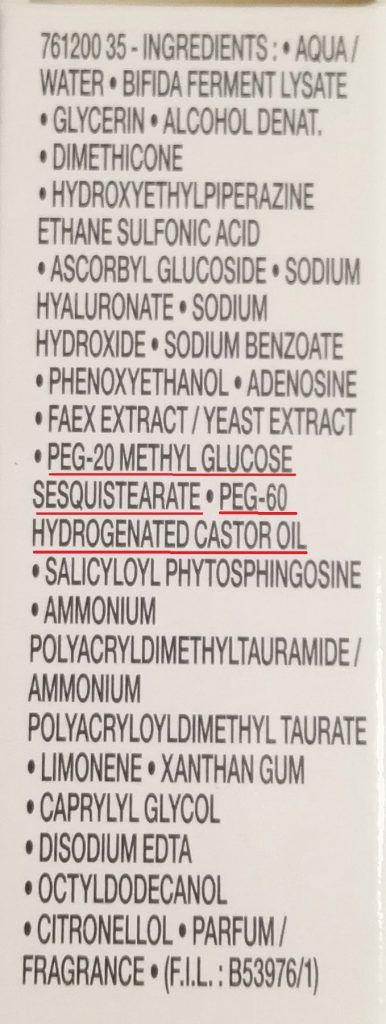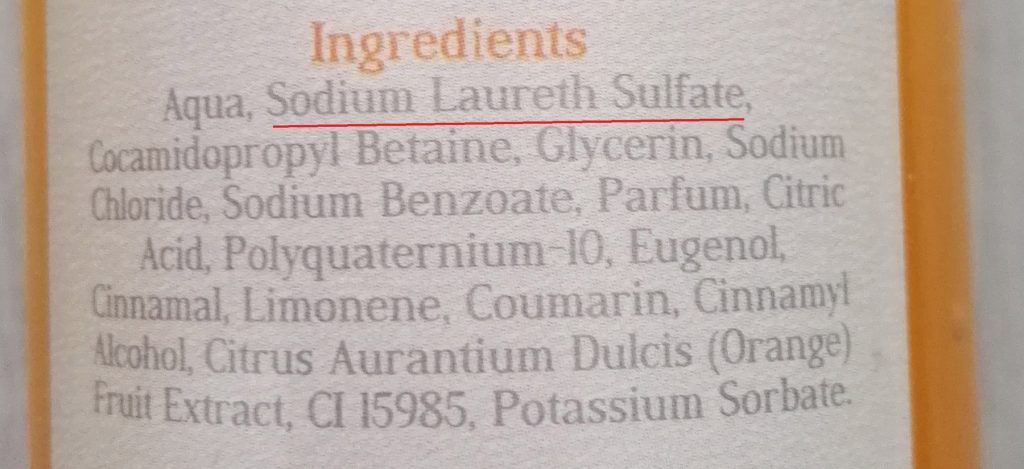
Ethoxylated ingredients: what they are and why they are not allowed in certified natural cosmetics.

We are going to dedicate some entries to talk about certain ingredients that are not allowed in certified natural and organic cosmetics. We will try to explain how to identify them when reading a list of ingredients in any cosmetic product and what is the reason or reasons why they are mainly not allowed.
On this occasion we are going to dedicate this article to ethoxylated ingredients. Ethoxylated ingredients are so named because a chemical process called ethoxylation has been used for their production. Ethoxylation is a process in which ethylene oxide is added to different chemical substances (fatty acids, alcohols, amines, phenols) in order to make them more soluble in water . The products that are generated are used as surfactants (or surfactants).
Surfactants are substances that influence the contact surface between two phases, -for example, two mutually insoluble liquids such as oil and water- through the decrease in surface tension. Surfactant molecules have a water-loving, or hydrophilic, part and a non-water-loving, or hydrophobic, part. This fact causes the surfactant molecules, under certain circumstances, to aggregate forming micelles, with the hydrophilic part facing out, in contact with water. This behavior means that surfactants can have emulsifying (or emulsifying) and detergent activity . In the case of detergents, the formation of these micelles is responsible for dragging the dirt, since the fat or oils -of a hydrophobic nature- are trapped inside the micelles.
The surfactants generated by ethoxylation can be of different types, although the most frequently used in the cosmetic industry are nonionic and anionic. The degree of ethoxylation, determined by the number that appears many times in the name of the ethoxylated surfactant (for example Laureth 4) determines different factors such as the degree of irritation (it decreases as the degree of ethoxylation increases) and the foaming capacity.
A well-known ethoxylated surfactant widely used in the cosmetic industry in washing products such as gels and shampoos is Sodium Lauryl Ether Sulfate or Sodium Laureth Sulfate (SLES). In this last name, the ending “eth” is a contraction or abbreviation of “ethoxylated”. Thanks to the ethoxylation process, this ingredient is much less irritating to the skin than its “cousin”, Sodium Lauryl Sulfate (SLS), which is produced in the same way as the former, but without undergoing the ethoxylation process.
And up to here, you will say and ask yourselves: “Well, wow, the ethoxylated ingredients are wonderful! They are less irritating and have great foaming capacity like detergents! So why doesn’t natural cosmetics benefit from them?”
Well, regardless of the natural origin of the ingredients -determinant in certified natural cosmetics as we have already explained in other entries- the fact of using a chemical ethoxylation process has several -and not insignificant- drawbacks, both environmental and for health.
First of all, the main component used in the ethoxylation process, ethylene oxide (Ethylene oxide), is classified as toxic by inhalation, mutagenic, carcinogenic, extremely flammable, serious eye irritant and skin irritant according to the information available from the European Chemicals Agency (ECHA). View image.
According to the Agency for Toxic Substances and Disease Registry https://www.atsdr.cdc.gov/es/phs/es_phs137.html ) “In large-scale studies of exposed workers to ethylene oxide in the plants that produce this substance or in the equipment sterilization rooms of hospitals -another of its uses is the sterilization of materials-, an increase in the rate of cases of leukemia, stomach cancer, pancreatic cancer and Hodgkin’s disease. Ethylene oxide has also been shown to cause cancer in laboratory animals. Leukemia, tumors in the brain, lungs and lacrimal glands have been detected in these animals.” Besides,http://www.prtr-es.es/Oxido-de-etileno,15653,11,2007.html ) Although it does not accumulate in the food chain, ethylene oxide is harmful to aquatic organisms.
Therefore, the use of ethylene oxide for the production of cosmetic ingredients cannot be described as an innocuous and healthy process, neither for health nor for the environment. And this is one of the reasons why the chemical process of ethoxylation and ethoxylated ingredients are not allowed in natural and certified organic cosmetics.
Secondly, as a consequence of the ethoxylation process, a series of trace impurities may appear in the ethoxylated product generated, both ethylene oxide, which we have already discussed, and other substances, such as 1,4 for example. dioxane.
In the European Union, both ethylene oxide and 1,4-dioxane are prohibited ingredients according to regulation (EC) No 1223/2009 (Annex II), however, their appearance as impurities in the final product is always allowed. that it is justified that its presence is technically unavoidable and that it remains within the limits set or recommended by the pertinent organisms.
1,4 Dioxane is a substance of the so-called CMR (carcinogenic, mutagenic or toxic substance for reproduction) that is listed as a carcinogen in the European Union (carc. 2 – H351). (See https://echa.europa.eu/es/substance-information/-/substanceinfo/100.004.239 ).
The levels of 1,4-dioxane impurities in cosmetics have been reduced in recent decades thanks to improvements in technical processes and the application of Good Manufacturing Practices. In studies conducted by the FDA (US Food and Drugs Administration https://www.fda.gov/Cosmetics/ProductsIngredients/PotentialContaminants/ucm101566.htm) in the 80s, the average levels of this substance were 50 ppm -parts per million-, with a variation of 2-279 ppm. In 1997 the average levels, however, had been reduced to 19 ppm (with a variation of 6-34 ppm). According to data from the latest studies carried out and collected by the FDA, SCCS (Scientific Committee on Consumer Safety, European Commission Health & Food Safety Directorate) (1), Campaign for Safe Cosmetics (See note at the end) (2) and ICCR (International Cooperation on Cosmetic Regulation) (3), 60% of the products analyzed had levels between 0 and 1 ppm, 19% between 1 and 5 ppm; 8% between 5 and 10 ppm; 6% between 10 and 25 ppm and only 1% had a level higher than 25 ppm, with a maximum of 35 ppm.
The levels of 1,4 dioxane as an impurity, considered safe by the SCCS in the final product are <10 ppm. This level is considered safe taking into account other possible sources of 1,4 dioxane: pharmaceuticals, detergents and household cleaners, agricultural and veterinary products, etc.
Although the data on the reduction of 1,4 dioxane levels in cosmetic products is encouraging, its simple detection in cosmetic products, even if it is below the recommended levels, is still worrying, especially when it is just one more source. exposure to a carcinogen. Therefore, and from my point of view, as recommended by the Campaign for Safe Cosmetics, the best option to avoid exposing yourself to another source of potential risk is to avoid, among others, ethoxylated ingredients. As I have heard my mother say many times, to whom I wink from here since I know she reads me ;-): “Avoid the occasion and you will avoid the danger”. Because in the end, the ultimate decision is that of the informed consumer who, beyond trusting in the good work of the authorities and that of the manufacturers,
Examples of ethoxylated ingredients that may appear in the ingredient list of a cosmetic product are:
PEG, PPG and compound names with them;
Denominations ending in “eth”: Ceteareth, Laureth, etc.;
Polysorbate and compound names.
Below are some product ingredient listings with underlined examples of ethoxylated ingredients. Some of them correspond to pseudo-natural products.







The responsibility for your health care is ultimately yours, and you apply it in every purchase decision. By choosing certified natural and organic cosmetics, you are avoiding ethoxylated ingredients. Ilurbeda is certified natural and organic cosmetics and, of course, none of the emulsifiers or any other ingredient used is neither ethoxylated nor harmful to health.[ 1 ] ICCR report: “Considerations on Acceptable Trace Level of 1,4-Dioxane in Cosmetic Products,” available on US FDA, “1,4-Dioxane in Cosmetics: A Manufacturing Byproduct” [2]Campaign for Safe Cosmetics, March 2009, Report titled “No More Toxic Tub” available at http://www.safecosmetics.org/wp-content/uploads/2016/12/NoMoreToxicTub_Report_Mar09.pdf
[3] Scientific Opinion on The Report of the ICCR Working Group: Considerations on Acceptable Trace Level of 1,4-Dioxane in Cosmetic Products,” 15 December 2015, SCCS/1570/15
Note: Campaign for Safe Cosmetics is a project of Breast Cancer Prevention Partners and is a US-based coalition of non-profit organizations (women’s, environmental, health, fair trade, consumer, and labor organizations) whose primary goal is is to protect the health of consumers and workers. To this end, it educates users about cosmetic ingredients at risk and requires the cosmetic industry to gradually eliminate chemicals that are carcinogenic, mutagenic or linked to other health problems, replacing them with safer alternatives.


